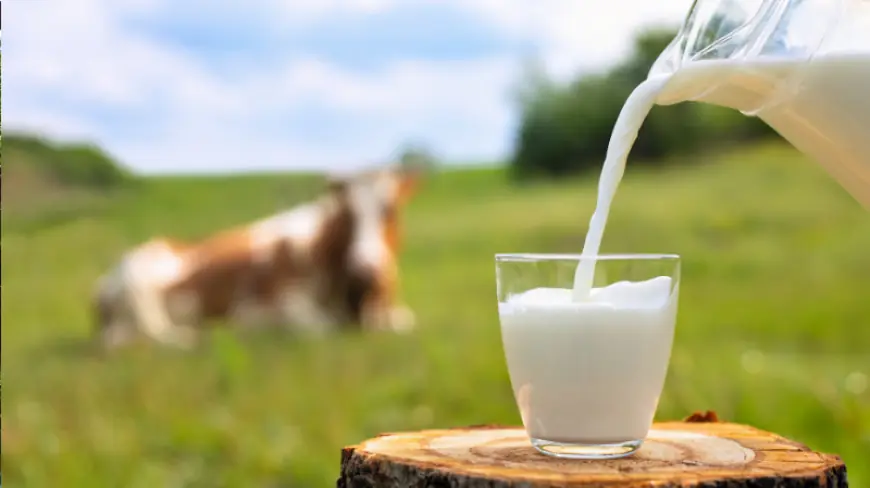Australia Milk Market: Growth, Trends, and Future Outlook (2025-2034)
The Australian milk market, valued at AUD 9.84 billion in 2024, is projected to grow at a CAGR of 7.20%, reaching AUD 19.72 billion by 2034. Discover the key drivers behind this growth, including high-quality milk production, technological innovations, sustainability efforts, and rising demand for dairy products both domestically and globally.

The Australian milk market, valued at AUD 9.84 billion in 2024, continues to thrive due to high-quality milk production supported by stringent regulations and advanced farming techniques. As one of the world's leading milk producers, Australia is recognized for its efficient dairy farming practices, contributing to both domestic consumption and international exports. This market has grown significantly, benefiting from innovations that focus on improving productivity and sustainability within the dairy industry.
The Australian milk market is projected to grow at a compound annual growth rate (CAGR) of 7.20% from 2025 to 2034, potentially reaching AUD 19.72 billion by 2034. The growth is driven by increasing demand for milk-based products, technological advancements in dairy farming, and a rising focus on sustainability. This article will explore the factors driving the market's expansion, the key trends shaping its future, and the innovations that are making the dairy sector more efficient and environmentally responsible.
Key Drivers of Growth in the Australian Milk Market
1. High-Quality Milk Production
Australia is known for producing high-quality milk that meets rigorous international standards. The country's dairy industry benefits from strict regulations governing milk production, ensuring that milk is free from harmful contaminants and of consistent quality. Australia’s robust regulatory framework for food safety and milk quality is crucial to maintaining the country's reputation as a trusted supplier of dairy products.
The adoption of advanced farming methods, such as precision agriculture, has also contributed to the improvement of milk quality. These methods enable farmers to monitor environmental factors, cow health, and feed efficiency, ultimately leading to better milk yield and quality. As demand for high-quality dairy products continues to rise, Australia's milk industry is well-positioned to meet both local and global consumer preferences.
2. Increasing Domestic and Global Demand for Dairy Products
The demand for milk and milk-based products, such as cheese, butter, yogurt, and cream, continues to rise both domestically and globally. In Australia, milk is a staple in households, and the increasing popularity of dairy-based beverages and processed dairy products is contributing to the growth of the milk market.
Globally, Australia benefits from a strong export market, particularly in Asia, the Middle East, and Southeast Asia, where the demand for high-quality dairy products has surged. Australia's reputation for producing clean, high-quality milk is a key factor in maintaining strong export relationships. As the global population grows and incomes rise in developing countries, there will be even greater demand for Australian dairy exports, further boosting the milk market's growth.
3. Technological Innovations in Dairy Farming
The Australian dairy industry has embraced several technological innovations aimed at improving productivity, reducing environmental impact, and enhancing overall farm efficiency. Innovations such as robotic milking systems, automated feed systems, and data analytics are transforming dairy farming, making it more efficient and cost-effective.
For instance, robotic milking machines allow for round-the-clock milking, improving cow comfort while increasing productivity. Automated systems can also monitor cow health and behavior, enabling farmers to quickly identify issues such as illnesses or poor milk production, which can result in better overall herd management.
The use of big data and artificial intelligence (AI) in the dairy sector is also enabling farmers to optimize feed management, enhance breeding programs, and reduce waste. These technological advancements are making Australian dairy farming more sustainable while improving the profitability of milk production.
4. Sustainability and Environmental Concerns
Sustainability has become a major focus in the Australian dairy industry as both consumers and businesses are increasingly concerned about the environmental impact of dairy farming. The adoption of sustainable farming practices, such as reducing greenhouse gas emissions, minimizing water usage, and optimizing waste management, is becoming a key driver of growth in the milk market.
In response to environmental pressures, Australian dairy farmers are investing in eco-friendly technologies that reduce the environmental footprint of milk production. This includes the use of renewable energy sources like solar power on dairy farms, efficient water management systems, and the development of feed solutions that lower methane emissions from cows.
Consumers are also increasingly seeking products that are produced sustainably, and dairy companies are responding by labeling their products with sustainability certifications. This growing consumer preference for eco-friendly products is driving demand for sustainably produced milk and dairy products.
5. Government Policies and Support
The Australian government plays a key role in supporting the dairy industry through various programs and policies. These initiatives aim to improve farm productivity, support innovation, and ensure that the milk market remains competitive both locally and internationally. For example, subsidies for sustainable farming technologies and research funding for dairy innovation help Australian farmers adopt new practices that enhance productivity and environmental stewardship.
In addition, the government is working on strengthening the Australian dairy industry’s global competitiveness through trade agreements and international market access. By opening up new export markets and ensuring fair trade practices, the government supports the continued growth of the Australian milk market.
Market Segmentation: Types of Milk Products
1. Liquid Milk
Liquid milk remains the most widely consumed dairy product in Australia. The liquid milk segment is segmented into various types based on fat content, including full cream, reduced fat, and skim milk. With a growing health-conscious consumer base, demand for reduced-fat and skim milk has been increasing, although full cream milk continues to maintain a strong market share.
Flavored milk and organic milk options are also gaining popularity in the Australian market. These variations cater to changing consumer preferences for different tastes and health benefits, driving growth within the liquid milk segment.
2. Dairy-Based Beverages
Dairy-based beverages such as milkshakes, smoothies, and coffee creamers have gained significant traction in the Australian market. These beverages are becoming popular as convenient on-the-go options for consumers. With increasing interest in plant-based milk alternatives like almond, soy, and oat milk, the dairy industry is responding by diversifying its offerings to include functional milk beverages that are fortified with vitamins and minerals to enhance their nutritional value.
3. Processed Dairy Products
The processed dairy segment includes cheese, yogurt, butter, and cream, all of which are essential components of the Australian diet. The popularity of cheese, particularly varieties like cheddar and mozzarella, has grown steadily, with demand also increasing for premium, artisanal, and flavored cheese options.
Yogurt consumption in Australia has also been on the rise, especially as consumers shift toward healthier snacking options. Greek yogurt, in particular, has seen significant growth due to its higher protein content and health benefits. The growing awareness of the nutritional value of dairy products will continue to boost the processed dairy segment in the coming years.
Market Forecast and Projections
The Australian milk market, valued at AUD 9.84 billion in 2024, is set to grow at a CAGR of 7.20% from 2025 to 2034. This growth is expected to bring the market to an estimated AUD 19.72 billion by 2034. Several factors are driving this growth, including rising domestic demand, technological innovations, sustainability efforts, and the expanding global market for Australian dairy products.
What's Your Reaction?
 Like
0
Like
0
 Dislike
0
Dislike
0
 Love
0
Love
0
 Funny
0
Funny
0
 Angry
0
Angry
0
 Sad
0
Sad
0
 Wow
0
Wow
0




















































